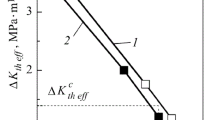Abstract
The change in dislocation configuration ahead of a loaded crack tip before and after charging with hydrogen wasin situ investigated in TEM using a special constant deflection loading device. The results showed that hydrogen could facilitate dislocation emission, multiplication and motion. The change in displacement field ahead of a loaded notch tip for a bulk specimen before and after charging with hydrogen wasin situ measured by the laser moire interferometer technique. The results showed that hydrogen could enlarge the plastic zone and increase the plastic strain. Thein situ observation in TEM showed that when hydrogen-enhanced dislocation emission and motion reached a critical condition, a nanocrack of hydrogen-induced cracking (HIC) would nucleate in the dislocation-free zone (DFZ) or at the main crack tip. The reasons for hydrogen-enhanced dislocation emission, multiplication and motion, and the mechanisms of nucleation of HIC have been discussed.
Similar content being viewed by others
References
Chu, W. Y., Wang, H. L., Hsiao, C. M., Mechanism of HIC and SCC in austenitic stainless steel,Corrosion, 1984, 40: 487.
Chu, W. Y., Hsiao, C. M., Li, Z., Hydrogen induced delayed plasticity and cracking,Scr. Metall., 1979, 13: 1063.
Bond, G. M., Robertson, I. M., Birnbaum, H. K., Effects of hydrogen on deformation and fracture processes in high-purity aluminum,Acta Metall., 1988, 36: 2193.
Pozenak, P., Robertson, I. M., Birnbaum, H. K., HEVM studies of the effect of hydrogen on the deformation and fracture of AISI type 316 austenitic stainless steel,Acta Metall., 1990, 38: 2031.
Gu, B., Zhang, J. W., Chu, W. Y., Thein-situ TEM observation of corrosion facilitating dislocation emission, multiplication and motion for brass,Scr. Metall. Mater., 1995, 32: 637.
Ohr, S. M., An electron microscope study of crack tip deformation and its impact on the dislocation theory of fracture,Mater. Sci. Eng., 1985, 72: 1.
Cherepanov, G. P.,Mechanics of Brittle Fracture, New York: McGraw-Hill, 1977, 29.
Li, J. C. M., Computer simulation of dislocations emitted from a crack,Scr. Metall., 1986, 20: 1447.
Bai, Q. X., Chu, W. Y., Hisao, C. M., Partial molar strain field of hydrogen in iron,Scr. Metall., 1987, 21: 613.
Wang, Y. B., Chu, W. Y., Hsiao, C. M., Research on mechanism of hydrogen-induced cleavage in Fe-3%Si alloy,Science in China, Ser. A, 1990, 33(6): 562.
Zhang, T. Y., Chu, W. Y., Hsiao, C. M., Mechanism of hydrogen-induced softening,Scientia Sinica, Ser. A, 1986, 29(11): 1157.
Birnbaum, H. K., Sofronis, P., Hydrogen-enhanced localized plasticity—a mechanism for hydrogen-related fracture,Mater. Sci. Eng., 1994, A176: 192.
Narita, N., Shiga, T., Higashida, K., Crack-impurity interactions and their role in the embrittlement of Fe alloy crystals charged with light elements,Mater. Sci. Eng., 1994, A176: 203.
Zhu, T., Yang, W., Guo, T., Quasi-cleavage processes driven by dislocation pileups,Acta Mater., 1996, 44: 3049.
Chu, W. Y., Gao, K. W., Chen, Q. Z.et al., Nucleating and propagation of nanocrack in dislocation free zone in brittle material,Science in China, Ser. A, 1995, 38(12): 1501.
Author information
Authors and Affiliations
Additional information
Project supported by the National Natural Science Foundation of China and the State Key Laboratory of Corrosion and Protection of Metal.
Rights and permissions
About this article
Cite this article
Lü, H., Li, M., Zhang, T. et al. Hydrogen-enhanced dislocation emission, motion and nucleation of hydrogen-induced cracking for steel. Sci. China Ser. E-Technol. Sci. 40, 530–538 (1997). https://doi.org/10.1007/BF02917169
Received:
Issue Date:
DOI: https://doi.org/10.1007/BF02917169




